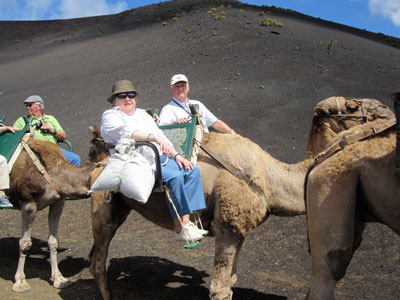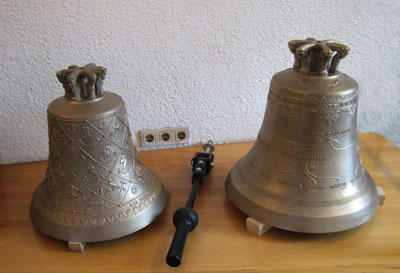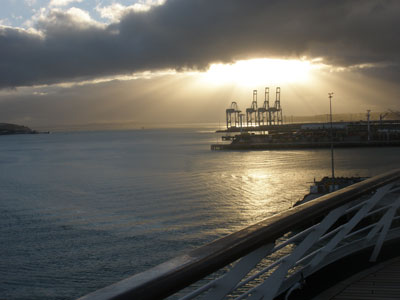A digital camera you can recommend — ultracompact cameras
We asked for your recommendation of a good, pocket-sized, point-and-shoot digital camera that has a viewfinder. But we also asked you to name the digital camera — of any type — that you prefer to use while on a trip. The response was impressive, so in this issue we’re printing subscribers’ comments just on “ultracompact” cameras (about the size of a deck of cards and, in most cases, weighing less than six ounces without batteries). Next month we’ll print responses on “compact” cameras (a step up in size but, generally, small enough to fit into a jacket or pants pocket and weighing less than 10 ounces without batteries). Reviews of larger cameras will follow.
For each camera reviewed, we’ve given the brand and model number and the year it was introduced, followed by the megapixels (mp) that it is capable of producing (more megapixels means pictures higher in resolution, that is, sharper) and the degree of optical zoom and digital zoom it’s capable of (for example, the optical zoom/digital zoom could be “5x/4x”).
(Note: optical zoom uses the optics, or lenses, to virtually “bring a subject closer,” as does a telescope. With digital zoom, the camera electronically enlarges the area you “zoom” in on and crops the rest of the image [this enlarging can, instead, be done later with image-editing software]. The image quality derived from optical zoom will be better than that from digital zoom.)
Also listed are each camera’s dimensions and weight, the size of the liquid crystal display (LCD) screen that it has plus the type of viewfinder it has, if any. (Particularly when composing close-ups, the LCD screen may give a better indication of how the final image will be framed than will an offset “optical viewfinder,” due to parallax.)
If the subscriber mentioned the price, we’ve included it. If no price was quoted, we show the top price that was listed at Amazon.com. (While older-model cameras may be difficult to find in “brick-and-mortar” stores, they are widely available online at sites such as Amazon.com, Bestbuy.com and eBay.)
Note: all of these cameras can also shoot video.
If you have a digital camera to recommend, write to Digital Cameras, c/o ITN, 2116 28th St., Sacramento, CA 95818, or e-mail editor@intltravelnews.com. Include the address at which you receive ITN (ITN prints letters from subscribers only). Be as specific as possible about the camera’s brand, name and model number plus how much it cost and when (year) you purchased it. Add any tips on how to use it better or tell how it came in handy. Examples of photos (outside of the US) are welcome; include captions and name the photographer.
Canon PowerShot SD780 IS ELPH — 2009, 12.1 mp, 3x/4x, 3.4"x2.2"x0.7", 4.1 oz., LCD 2.5", optical viewfinder
• I like to have a viewfinder as an option on my point-and-shoot digital camera, but the number of companies that are still making them is very limited. I bought my SD780IS on Amazon.com in 2010 for $189.50. Its compact size and the quality of the pictures is very good. — DAVID M. REEVES, Banning, CA
• This camera is slim enough to fit into just about any pocket. It can capture high-definition movies. Note that the viewfinder image is not quite the same as the photo, which takes a bit of getting used to.
I purchased mine about two years ago in Australia, where it was called an IXUS 100 IS. In the US, I kept getting blank stares from salespeople when I asked about a pocket camera with a viewfinder. — GEORGE COHEN, Warren, NJ
• I prefer an optical viewfinder on my cameras and currently use a Canon PowerShot SD 780 IS that I paid about $175 for in May 2010; I have enjoyed it immensely. It’s always in my pocket, even though I also take a full-feature Nikon DSLR (digital single lens reflex) camera on my travels.
Surprisingly, even with the presence of the little peephole viewfinder on the back of the Canon PowerShot, I find myself using the screen to compose shots more often that I would have expected.
When I can plan my shots, the big SLR camera is clearly superior, but when traveling, and I mean really traveling, as in a helicopter or bus, or racing to catch up with a tour guide, I find the little point-and-shoot to be invaluable, even in poor lighting conditions.
If I can’t spend any time composing, I just try to see the picture I want in the screen and then snap two or three quick exposures. Later, when editing, I find I can usually edit and crop one of them and get as good a picture as the SLR would have given me under the same circumstances. The Canon’s having 12 megapixels helps. — STEWART WINN, Williamsburg, VA
Canon PowerShot A1100 IS — 2009, 12.1 mp, 4x/4x zoom, 3.4"x2.2"x0.9", 4.4 oz., LCD 2.5", optical viewfinder, $182
• My husband, Ray, and I always travel with at least two digital cameras, so we always have a backup. In addition, I always carry backup batteries and memory cards in my day pack and battery chargers in my luggage.
Because bright sunlight frequently washes out the camera’s LCD screen, because using the screen eats more battery power and because we prefer to not hold out a camera and obstruct the view of fellow travelers’ while using the screen as a viewfinder, we will only purchase cameras with viewfinders.
To reduce the need for multiple battery chargers and to ensure battery availability in remote places, we prefer cameras that take standard AA or AAA batteries. We prefer adequate zoom and/or quality focus capabilities combined with enough pixels to enable post-photography editing (I still use Photoshop Elements 5.0).
One of our cameras is the pocket-sized Canon PowerShot A1100 IS, which I highly recommend. It’s lightweight and has a viewfinder and a 4x optical stabilized zoom and uses two AA batteries. In May ’11, a huge wave at Rosh HaNikra, Israel, drowned my A1100 IS. Although this camera model has been discontinued, I later was able to obtain a replacement via Amazon.com for $249.
As for tips for using the camera better, I suggest the novice scan the photocomposition sections of photography books. Anyone can point and shoot, but an introduction to photocomposition can enhance photos as well as how you visualize the world.
Also, I urge photographers to be considerate of other travelers. Avoid being the aggressive photographer who always holds his camera in front of others and does not step aside quickly when he has his shot.
Finally, be sensitive to the feelings of strangers you photograph. Not everyone wants their photograph taken. But enjoy the magic of photography and how it can sharpen your view of the world! — WANDA BAHDE, Summerfield, FL
• The first 35mm camera I bought to take overseas was an Argus C3; this was in 1946 and I was in the army headed for Japan. Between then and now I have owned more than a dozen cameras, most of them Canons.
Before buying my first digital camera, I did a lot of research and established a careful list of specifications. I continued to update these as improvements such as Optical Image Stabilization were developed.
In 2009 I convinced myself that having a pocket camera again would be useful. There was only one that had a viewfinder, the Canon PowerShot A1100 IS. LCD screens just don’t make it in bright sunshine or most of the time, for me.
My major tip in choosing a camera is to immerse yourself online at these two sites: dpreview.com and dcresource.com. You will learn a lot and have great fun! — CARL HAAG, Princeton, NJ
Canon PowerShot SD1100 IS ELPH — 2008, 8mp, 3x/4x zoom, 3.42"x2.16"x0.87", 4.41 oz., LCD 2.5", optical viewfinder, $250
• This camera is about the size of a deck of cards, and I paid about $200 for it three years ago. I bought this camera because the big screen is very easy to turn off (extending battery life) and I can frame my pictures using the small viewfinder. However, I have to turn on the big screen when I hand the camera over to someone to take my picture. I find that most people have forgotten or don’t know how to use a viewfinder.
Using the viewfinder, it is so much easier to get a picture in bright sunlight, plus I find that the camera is much steadier to hold. This camera also has an image-stabilizer feature. The only disadvantage, perhaps, is that it has only a 3x zoom, but, at 8 megapixels, most of the pictures are excellent.
One bit of advice on taking a camera overseas — have two or more fully charged batteries before you leave home. I always take the battery charger, which is very, very small, but it is nice to be carrying an extra battery when the inserted battery dies without warning. (With this camera, there is little or no warning that the battery is dying.)
In Petra, Jordan, in October ’08, I took two pictures of the Treasury and then the camera died. I had to rely on other people in the group to share their pictures. But it did not diminish my enjoyment of Petra. — JANET LANDFRIED, Redlands, CA
• In the mid ’90s, Canon introduced a small APS (advanced photo system) film camera they called an ELPH. Today that same name is used for positively the best, small point-and-shoot digital camera on the market: the Canon PowerShot SD1100 IS ELPH. I bought mine in 2008 and have used it ever since. It has a very bright LCD display.
I must admit that for most of my photography I use the LCD, but outdoors under bright conditions I do still use the small optical viewfinder.
Unfortunately, the newest version of the ELPH has deleted the viewfinder, and unless you own a DSLR (a much bigger camera), you are out of luck in that respect with most new point-and-shoot cameras. — ALAN TAVROGES, Weston, FL
• My husband and I have a Canon Powershot SD1100 IS ELPH. I like to use the viewfinder, though he prefers the screen. The camera is lightweight and fits in a shirt or pants pocket. Wonderful! — KATHLEEN CAPPS, Houston, TX
Canon PowerShot SD1000 ELPH — 2007, 7.1mp, 3x/4x zoom, 3.38"x2.11"x 0.76", 4.41 oz., LCD 2.5", optical viewfinder
• I can recommend this camera. It has a viewfinder and fits nicely in my pocket, even a jeans or jacket pocket. It takes great photos, too. I think it cost about $200.
This is actually my second one. I drowned the first one in the bottom of a tote when a bottle of water came open. The chip was saved, but that was it for the camera. — LISA CUBBON, Marietta, GA
Canon PowerShot SD800 IS ELPH — 2006, 7.1 mp, 3.8x/4x zoom, 3.52"x2.28"x0.99", 5.29 oz., LCD 2.5", optical viewfinder, $699 new ($60 used)
• I usually use DSLR cameras, but — as a backup and to use when I don’t want to lug the big baby! — I also carry a small point-and-shoot, a Canon PowerShot SD800 IS ELPH, which is long out of production but does well and has video capabilities too.
It is nearly impossible to see what you are photographing on an LCD screen if the ambient light is bright. There are now just a few point-and-shoot cameras with viewfinders, but finding one is worth the effort, as it makes for much easier picture taking. Offering more flexibility, many of the micro-four-thirds cameras (featuring built-in interchangeable lenses) have both built-in and detachable viewfinders.
Many of the point-and-shoots now have image stabilization built in, which enables using them under less-than-ideal conditions. It is harder to hold a small camera still than a larger one!
Reviews of cameras can be found on a variety of websites, like cnet.com and dpreview.com.
I recommend always buying an LCD screen protector made of a firm material like acrylic. This will protect the screen from dirt, scratches and fingerprints as well as from breaking and leaking if dropped or pressed. It has to be the size of the LCD screen and is attached with the included adhesive. I like this better than the peel-off type, which offers less protection and tends to wrinkle. I once had a camera smashed, and the monitor cover saved it from more serious damage.
There also are mini-pop-up shades that cover the screen and shade it from light, but I have found them to be a nuisance. The main goal is to protect the LCD. — JUDY BURR, Kensington, MD
Canon PowerShot A530 — 2006, 5 mp, 4x/4x zoom, 3.56"x2.5"x1.7", 6 oz., LCD 1.8", optical viewfinder, $200 new ($30 or less used)
• I love this camera and can think of only one disadvantage: it’s resolution is only 5.0 megapixels. I paid about $200 for it several years ago. — WILLIAM KLETT, St. Paul, MN
Kodak Playsport Zx5 camcorder — 2011, 5.5mm lens (35mm equivalent), captures still jpg pictures, 4x digital zoom, LCD 2.0", 2.3"x 4.4"x07", 4.4 oz.
• My wife, Liz, and I spent six weeks in Ecuador, May 10-June 24, 2011. The jungle, zip-lining in the cloud forest and snorkeling in Galápagos all were caught on the Kodak PlaySport Zx5.
This amazing little camercorder is waterproof to nine feet and shockproof to four to five feet. It fits into your pocket and takes only a few seconds to begin filming.
We bought ours at Best Buy for $149, but they do go on sale for $125. The battery life is long enough to capture the day’s adventures, though I have a spare in my backpack, and downloading to a computer is easy. An impressive pocket camcorder! — SCOTT CAPEN, Paradise, CA
Nikon COOLPIX P60 — 2008, 8.1 mp, 5x/4x zoom, 2.5"x3.7"x1.42", 5.64 oz., LCD 2.5", electronic viewfinder, $350
• I found it a problem using the screen on the back of my digital camera, especially in stark light. On a South American cruise my old camera had to be replaced, and in Panama City I found the Nikon Coolpix P60 with an electronic viewfinder, which solved the problem.
It is a small, easy-to-carry camera and takes excellent pictures. — ULF GUSTAFSSON, San Francisco, CA
Nikon COOLPIX S210 — 2008, 8 mp, 3x/4x zoom, 2.17"x3.54"x0.71", 7.76 oz., LCD 2.5", no viewfinder, $130
• This camera takes quality photos in natural light, but in low light the pictures can be grainy, and flash shots are not nearly as good. One feature — it takes excellent close-up shots (within a few inches of the subject) if there is enough light.
For what I need in a camera, I am content to sacrifice higher-quality/resolution for small size and convenience. This one has acceptable video capability to capture the action at a soccer match as well as the crowd’s chants and songs.
I used an SLR for years, but now I can’t imagine going back to lugging any more camera gear than what I can put in my breast pocket.
Tips? Do your best to hold the camera as steady as possible. The best shots are usually taken in natural light. Take advantage of the luxury of digital by shooting plenty of shots, and use the highest resolution setting possible. Finally, always bring an extra memory card and battery. — BILL BLANCHARD, Albuquerque, NM
• One of my hobbies is photography, and it is not unusual for me to take over 5,000 pictures on a month’s trip. On overseas trips, I opt for a point-and-shoot digital camera. A few years ago I bought a Nikon Coolpix S210 for about $170. In 2010 I took it on our around-the-world trip to China, Spain and Italy.
In China, it was heavily overcast most of the time, and, being with a bunch of dignitaries, we were rushed around a lot, making it hard to stand still to take pictures.
When I put the pictures into a PowerPoint presentation, I was not happy with the results, as often the pictures were not clear. I then realized that the camera was okay but not for the style of pictures I was taking. — STEVE JONES, Valencia, CA
Olympus Stylus Tough-6000 — 2009, 10 mp, 3.6x/5x zoom, 3.8"x2.5"x0.88", 5.3 oz., no viewfinder
• I bought this at Costco in 2010 for about $400. This is a rugged camera that can be dropped and withstand shocks. It’s also waterproof and freeze-proof. It is easy to use and has many features if you want to get more technical. It even has a feature that softens wrinkles in pictures of faces. — MARLENE IMBSEN, Oceanside, CA
Olympus FE-340 — 2008, 8mp, 5x/4x zoom, 3.8"x2.3"x0.7", 4.1 oz., LCD 2.7", no viewfinder, $159
• My Olympus was my first digital camera, and it has been to Mexico, Australia, New Zealand, the Caribbean, Hawaii and Alaska. It has proven itself to be reliable in rain, slight snow and bright sun.
I’ve done a lot of “zooming,” especially in Alaska, and I never had one out-of-focus photo. I took so many photos from motorcoaches on tour in New Zealand and my camera always did a good job.
It has no disadvantages. It has excellent, easy functions and zooms in and out very well. I love it! — SHARON VANDEWARK, San Diego, CA
Sony Cyber-shot DSC WX-10 — 2011, 16.2 mp, 7x/6x zoom, 37⁄8"x21⁄8"x15⁄16", 5.7 oz., LCD 2.8", no viewfinder, $279
• I’m an avid travel photographer now on my third-generation Sony Cyber-shot, bought in May ’11. I want my camera small, light and simple but with the capability to take quality photos. I took photos for my travel writing in the past and gladly donated all that heavy equipment in exchange for my digital Sony.
In the five-plus years that I have been using the Sony Cyber-shots, I have not been disappointed with each camera’s capability nor with the results. Now I use my photos for calendars, cards, slide shows on my iPad, and iMovies that I play on my HDTV.
This camera can take panorama shots and features some of the smoothest 1080i (high-def, interlaced scan) video capture I have seen. The sound is excellent, and I noticed a big improvement with wind reduction on this model. I really like that I now can take close-ups and the macro setting kicks in automatically.
I do not like the control button for taking movies, but it is separated from the photo button in order to allow the taking of stills at the same time as shooting video.
The movie format is AVCHD (Advanced Video Coding High Def), so I can download directly into iMovie or use Sony software to preview and download from the camera. To me, this is not quite as convenient as with the earlier generations of camera.
The response time when using some of the superior settings is a little sluggish because of the special processing the camera does automatically. However, for normal use, set on “auto,” the camera takes good pictures at a second’s notice.
There is no viewfinder, and, as with most cameras, it is hard to see the screen in bright light. However, with practice I have come to love not being chained to that viewfinder and not having to look like a typical tourist with a camera pinned to her face. Instead, it becomes easy to point and shoot for the casual, quick and inconspicuous photo.
And because memory chips are so inexpensive, I don’t hesitate to use the camera to document information, from pictures of the rental car (making sure time and date are accurate) to street signs and brochure information that I can read later.
What I love most about this camera is its ability to play slide shows. While traveling, it has become a tradition for my travel mates and me to gather for a nightcap. I hook up my Sony to the room’s television using my video cables (extra cost).
There is excellent music already loaded on the camera, but I choose to download appropriate music of my own. For example, during my recent visit to Turkey, I downloaded Turkish instrumentals to play behind that day’s photos of Istanbul. I also have a 2G-memory chip with pictures from home that I can show on the TV as well. — PATRICIA BUNYARD, Cambria, CA
Sony Cyber-shot DSC T-5 — 2005, 5.1 mp, 3x/6x zoom, 33⁄16"x 25⁄16"x13⁄16", 3.98 oz., LCD 2.5", no viewfinder
• I bought this camera in 2006 at the Narita Airport in Japan; $344 included the camera, a battery charger and a 1G memory stick PRO Duo. It fits in my shirt pocket with ease, so it’s always at hand.
The shutter is well positioned. The focusing controls are easy to manipulate. I’m pleased with the pictures it takes. The battery charger is easy to set up and use. What could be better?
However, the LCD screen is not too readable in the sunlight, and the lens cover won’t lock and can move, allowing the battery to expire.
Like many Japanese products, it will perform many, many functions governed by miniature controls and with many instructions. — ROBERT COOK, Midland, MI





